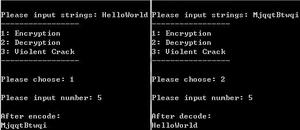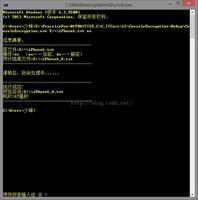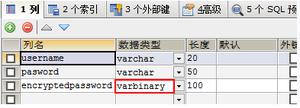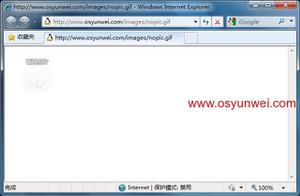PHP生成公钥私钥,加密解密,签名验签

test_encry.php
<?php//创建私钥,公钥//create_key();
//要加密内容
$str = "test_str";
//加密
$encrypt_str = test_encrypt($str);
//解密
$decrypt_str = test_decrypt($encrypt_str);
//echo $decrypt_str;exit;
//签名
$sign_str = sign ( $decrypt_str );
// echo $sign_str;exit;
//验签
$res = verify ( $decrypt_str, $sign_str );
var_dump ( $res );
exit ();
//创建秘钥对
function create_key(){
//配置信息
//配置需要用到环境配置文件 openssl.cnf,这里文件地址如下
$config_path = "D:\ApacheServer\Apache\conf\openssl.cnf";
$config = array(
"digest_alg" => "sha512",
"private_key_bits" => 4096, // 字节数 512 1024 2048 4096 等 ,不能加引号,此处长度与加密的字符串长度有关系
"private_key_type" => OPENSSL_KEYTYPE_RSA, // 加密类型
'config' => $config_path
);
$new_key = openssl_pkey_new($config);
if ( $new_key == false ){
returnfalse;
}
//提取私钥
//$private_key 这里作为引用变量
openssl_pkey_export($new_key, $private_key, null, $config);
//生成公钥
$public_key = openssl_pkey_get_details($new_key);
// var_dump($public_key);
$public_key = $public_key["key"];
//显示数据
//var_dump($public_key); //公钥
//var_dump($private_key); //私钥
file_put_contents("./testpublic.pem", $public_key);
file_put_contents("./testprivate.pem", $private_key);
openssl_free_key($new_key);
}
// 数据接收方创建一套密钥对,把公钥给发送方(一或多个发送方),发送方用公钥加密数据,发给接收方,接收方用私钥解密获取数据
// 接受方的密钥对
/**
公钥加密
@param $str 要加密的明文
*/
function test_encrypt($str) {
$cert_file = "./testpublic.pem";
// 读取公钥内容
$public_key = file_get_contents ( $cert_file );
// 转成openssl对象
$public_key = openssl_get_publickey ( $public_key );
// 进行加密,$encrypt_str 为引用变量
openssl_public_encrypt ( $str, $encrypt_str, $public_key );
// base64转码
$encrypt_str = base64_encode ( $encrypt_str );
return$encrypt_str;
}
/**
私钥解密
@param $encrypt_str 要解密的密文
*/
function test_decrypt($encrypt_str) {
$cert_file = "./testprivate.pem";
// 读取私钥内容
$private_key = file_get_contents ( $cert_file );
// 转成openssl对象
$private_key = openssl_get_privatekey ( $private_key );
// base64解码
$encrypt_str = base64_decode ( $encrypt_str );
openssl_private_decrypt ( $encrypt_str, $decrypt_str, $private_key );
return$decrypt_str;
}
// 数据发送方创建一套密钥对,把公钥给接收方,发送方用私钥签名数据,发给接收方。接收方将“解密后的明文、收到的签名、发送方生成的公钥”三个数据一起来验签,验证通过则表示发送方是真实有效的(签名就是为排除冒充发送方发信息的行为)
// 发送方的密钥对(这里为方便,用同一套密钥对)
/**
私钥签名
@param $plain 要签名的明文
*/
function sign($plain) {
// $log = new Logger();
try {
// 用户私钥证书
$cert_file = "./testprivate.pem";
$priv_key = file_get_contents ( $cert_file );
$pkeyid = openssl_get_privatekey ( $priv_key );
if (! is_resource ( $pkeyid )) {
returnFALSE;
}
// compute signature
openssl_sign ( $plain, $signature, $pkeyid, OPENSSL_ALGO_SHA256 );
// free the key from memory
openssl_free_key ( $pkeyid );
// $log->logInfo("Signature string for:".$signature);
returnbase64_encode ( $signature );
} catch ( Exception$e ) {
// $log->logInfo("Signature attestation failure".$e->getMessage());
}
}
/**
公钥验签
@param $plain 验签明文
@param $signature 验签密文
*/
function verify($plain, $signature) {
$cert_file = "./testpublic.pem";
$signature = base64_decode ( $signature );
$cert = file_get_contents ( $cert_file );
$pubkeyid = openssl_get_publickey ( $cert );
if (! is_resource ( $pubkeyid )) {
returnFALSE;
}
$ok = openssl_verify ( $plain, $signature, $pubkeyid, OPENSSL_ALGO_SHA256 );
@openssl_free_key ( $pubkeyid );
if ($ok == 1) {
returnTRUE;
} elseif ($ok == 0) {
returnFALSE;
} else {
returnFALSE;
}
returnFALSE;
}
testprivate.pem
-----BEGIN PRIVATEKEY-----MIIJQgIBADANBgkqhkiG9w0BAQEFAASCCSwwggkoAgEAAoICAQDI7ysitVvgmHod
BwccHcgbaKANaDyMXJ30wkJRcaygZohZJkMlExsz9lPtlPUMrkH
+QkJSzzIP9Nr246LCKG5xDzRBzJbgcdsqjQk4sdSDGdiqOyIloHvYkQQvFRcStGjrIGswiU3NXvU3
kRG1ep1DvbsYTKYpkWkMxj9UJhgdkhoGgWgV6ijsbKiS2q6hcjfyh1A4fL9IT
+Ge5zewuzzY6HFCoWnJ40EsC6AbxqpK
+JL78pmG6K8KFNF3mu98IgH8ziNn15qvGjROFLysyTynMf42uKJNzZVN
/keo3kxesNZDn/W3D+QiWyZCigkZZ9TAVsfzYNFfcYRH3GZgZ3LgzjwX7heQUUMnDy8lHaK9yhodW30d7fDt5veghojWYkkVlrag50PJyJqs
U6TihB
/tqtFeFChIBhcHYSZ/Z5ISlCUJl3geB5uuUJRfusjRpdVsB4RzyaWziXXpd4Gbl3LoRPBo7ehzvt
+4pnqkRPZigYKuaXF5q7KQ0OtRhtuGj56VHizXqv8TAcsU+xGMxeFoDR0mwpPkJ/G3bawuEPAlrBdDyzDWltE3wU6GeHsh6KCOBBv4XjkkZk/Lsm3q4QAFZm31gL7dJzC4UiPHf264GG35Xgdso9OJlIhlihNwo4yZCtP
/yuykXwwjyjSOT7s9JrFLwjn
/j8rE0rmWp/p1nwIDAQABAoICAGaWVXufBI2iy5XOZL7iJax4ul6d
/WvcTXkNRTa3xt8N+kcp1dYz7wuUlD0UdBhJT8A0rBADYRfsd27dwddHNTvb+14syktFVhRfdXnQsSNOKuSe1ExJp3FmeLBhICqYmYiSQKfDMknMVX5NPrFdLLXNRJyfZaaLawrunJ6l5GIUmd0AbNfjeYlb4KU5qTccTZwxoa91YWPWBOdQPYqpzeMg
qdLO
/mfo8vk95jzILWGhj8m6js/mNJf9EQTzwZmq80DTLhhyZ7NGubWzuLCu/ZyPVa8yjQsUD0qGrKd2957QwlQ8cwNHxb4Us2
/9ca/a5zBcHjIQGFWWa2cVC9/kcS2V6YP7wg0mS4s1VHh3CM
+i9p3DvsPCpTIu9Kvv7fPZGuLqeUwWVcGx39w7B7QOqS/j+0sgcndwl0OO2hoLvprav75Pvk+aIQKccDc1P8c8auCTblp1dSZ0WRDCGH9JZaYpmUMvNllWIkiZU
+eye8mL824zC3XcqjTNJOT2+JEregy5aDYnxxABFWre7gXYbtXL8KGfS
+qJuD/Eqryg9b/IEuJpTUn432vjEmnfSEXRAf6W3Bn5VeSDp80VtYRUcg9jMNCtf
/Yap9wB0dMG4SJT66tVpd4h6cMVty9/IS9Klnewb6gEhLaK0utTfujOQ6kIn5W1qoIImiLnlbK4Ac3BAoIBAQDqAGMbE1IV6G7P67hWYLz1nPAwjpG2dj
+fXcRm7qFzwYoXU3bXH9Fcf6EtxK6jZYX1J2hxVD2gv9Gqnv8zdM1v47if5xb3HMpYz6ah
LjW
+6lu+D+dLBdmtKYGpAnvNqB8+1JviqbF/QDMH5RLZ9wFwqTErafEE4Cq/C1R3kCaIY
/5KC+pjJE7IIp7nYBpwH26tDVGUw873LysOzLLEu3Cyt1jn90nIVw6HzISLORIPIwiiTn3
+Je9M0ucxb6gbJixsKQr2tjY1nlHD9DFPFQKbdgmB0NiDV325VAJEbTZaeHyHyzgl1lzLHTD1V5NxCrtJvjw4640YAzNx08ltMZoJAoIBAQDb0vdJKXND
8t6tvsZUHe6ACT54qUPEVzw
/xnU6rBS+bhzyVU/UsapTD1Y6MnjurIWpZedYmiOmsIKicMk1uzn9096LMavkg3Hdu9HwY3UYU7h
/cso5R4eGbZogIz3D8I24OgA1rkZE66Sfvksx3UlRwKc2LqNtzoA12hiyJ9fXZrfaq6
/7RlcXXvtqJEvgwSlPXT+HAsdxzVcNS4C3g8
/UibvZKJINyRzfTRYkkrmRY7HP5OoBsbhwVrlfJ/0akwgosYecPPT2i5YR85D7GUdmB
/LJv/2uRbeT4XFFVow2nG73dK9f8ppVdcWkVtdz0Vm1d0gNRJhU3APSvSRv6JxnAoIBAGYOayr43zks2X
+XWBtcL62Tl/IljAmfQxpXg/w8oW/h/j80KMWkW
+RSydIzUNN0yNrmKBgdXI+KeYBHvhgMHjlpgTFEUXDPPrVDQ3JSvCAbCI45U3AWCh0K2EEFE0fbxlzZz28pAX
/1WQxdbT5hC2C+efJsTzEIL7yIzXskBJpBujtDPSOmRzHkX5ecA4vZOaUCBQ2z5MVL7iSTRHinI3zemEj7QlO9HFo
/6aLq7iRp7C8Vur
+ofdjstuaJwzCsEn3N3LlDORtjhFfJXeQWzr9M2NKkannGI9A7go2jcCw/FlkHWeKuvmPbxGmMm4KW4p5D
+PH+UdgiNUK00snr8zkCggEBAIf50KM986H1as74sj+4IB6tGSqUMWoTOB6PCVbYuSAuhtNT
+ESt/ZjRZNos/GdO6oMlmNxSxHjIuJX4xE3rWWzskL1zZUu
+D0JEexGCxBzfNMIJZJPX7jo2M99rTTqV42Qw5I5QFgFt7fAuSt82bbMXQ5edc9Rppx8ooJwbT0VbsaCfEQWSti6rv0Mh3pnRglcobDJ8gpiflxiPOrjJ
3VYwOLWUhfvnCmgKjAblh8oqbAQYKrQPlfJPgu0clFDK4IIjhqobfr
+/Cn5iNq1MLsEra4BmtWoGkA72phVo
+uSREYcac50bOWJhrncAjNeEiURZ24TxiHT9f5PtEcvzjEMCggEAHsyUceW0TEz5dHP
/kTuxuGy7tn3mtvr+bAfQH7g3E7PYvN0P58iJHASiVCCuzMApmHeKfErLt2Up2
/1527HDonAJJ9X50M5pZvvrIzAKFZmk/s00XpzPSCwXvcKN55kAgHrlj5P76xQ91EdZMqPoLNFRIuIT4wEPUqngFtvGNljuRHWjQkTa2So3
BlI0LJUxajbVANcRdyGcKy6KjsVj0lrYRiZXsH
/FQqX4EfscnljqEtB43bKQTAQoM4pBbJ17bq5B3hp4IIGlyKQDyXO68Y7KX5vlLkc2uunc9P
/HeWUhMWXWnbccsA8U0S0WEmpb0TnqG
+rz/3OOS5J0DaHv9Q==-----ENDPRIVATEKEY-----
testpublic.pem
-----BEGIN PUBLICKEY-----MIICIjANBgkqhkiG9w0BAQEFAAOCAg8AMIICCgKCAgEAyO8rIrVb4Jh6HQcHHB3I
G2igDWg8jFyd9MJCUXGsoGaIWSZDJRMbM
/ZT7ZT1DK5B/kJCUs8yD/Ta9uOiwihucQ80QcyW4HHbKo0JOLHUgxnYqjsiJaB72JEELxUXErRo6yBrMIlNzV71N5ERtXqd
Q727GEymKZFpDMY
/VCYYHZIaBoFoFeoo7GyoktquoXI38odQOHy/SE/hnuc3sLs82OhxQqFpyeNBLAugG8aqSviS
+/KZhuivChTRd5rvfCIB/M4jZ9earxo0ThS8rMk8pzH
+NriiTc2VTf5HqN5MXrDWQ5/1tw/kIlsmQooJGWfUwFbH82DRX3GER9xmYGdy4M48F
+4XkFFDJw8vJR2ivcoaHVt9He3w7eb3oIaI1mJJFZa2oOdDyciarFOk4oQf7arRXhQoSAYXB2Emf2eSEpQlCZd4HgebrlCUX7rI0aXVbAeEc8mls4l16XeBm5dy
6ETwaO3oc77fuKZ6pET2YoGCrmlxeauykNDrUYbbho
+elR4s16r/EwHLFPsRjMXhaA0dJsKT5Cfxt22sLhDwJawXQ8sw1pbRN8FOhnh7IeigjgQb
+F45JGZPy7Jt6uEABWZt9YC
+3ScwuFIjx39uuBht+V4HbKPTiZSIZYoTcKOMmQrT/8rspF8MI8o0jk+7PSaxS8I5
/4/KxNK5lqf6dZ8CAwEAAQ==-----ENDPUBLICKEY-----
openssl.cnf
##
OpenSSL example configuration file.#
This is mostly being used for generation of certificate requests.#
# This definition stops the following lines choking if HOME isn't
# defined.
HOME = .
RANDFILE = $ENV::HOME/.rnd
# Extra OBJECT IDENTIFIER info:
#oid_file = $ENV::HOME/.oid
oid_section = new_oids
# To use this configuration file with the "-extfile" option of the
# "openssl x509" utility, name here the section containing the
# X.509v3 extensions to use:
# extensions =
# (Alternatively, use a configuration file that has only
# X.509v3 extensions in its main [= default] section.)
[ new_oids ]
# We can add new OIDs in here for use by 'ca', 'req' and 'ts'.
# Add a simple OID like this:
# testoid1=1.2.3.4
# Or use config file substitution like this:
# testoid2=${testoid1}.5.6
# Policies used by the TSA examples.
tsa_policy1 = 1.2.3.4.1
tsa_policy2 = 1.2.3.4.5.6
tsa_policy3 = 1.2.3.4.5.7
####################################################################
[ ca ]
default_ca = CA_default # The default ca section
####################################################################
[ CA_default ]
dir = ./demoCA # Where everything is kept
certs = $dir/certs # Where the issued certs are kept
crl_dir = $dir/crl # Where the issued crl are kept
database = $dir/index.txt # database index file.
#unique_subject = no # Set to 'no' to allow creation of
# several ctificates with same subject.
new_certs_dir = $dir/newcerts # default place for new certs.
certificate = $dir/cacert.pem # The CA certificate
serial = $dir/serial # The current serial number
crlnumber = $dir/crlnumber # the current crl number
# must be commented out to leave a V1 CRL
crl = $dir/crl.pem # The current CRL
private_key = $dir/private/cakey.pem# The private key
RANDFILE = $dir/private/.rand# private random number file
x509_extensions = usr_cert # The extentions to add to the cert
# Comment out the following two lines for the "traditional"
# (and highly broken) format.
name_opt = ca_default # Subject Name options
cert_opt = ca_default # Certificate field options
# Extension copying option: use with caution.
# copy_extensions = copy
# Extensions to add to a CRL. Note: Netscape communicator chokes on V2 CRLs
# so this is commented out by default to leave a V1 CRL.
# crlnumber must also be commented out to leave a V1 CRL.
# crl_extensions = crl_ext
default_days = 365 # how long to certify for
default_crl_days= 30 # how long before next CRL
default_md = default# use public key default MD
preserve = no # keep passed DN ordering
# A few difference way of specifying how similar the request should look
# For type CA, the listed attributes must be the same, and the optional
# and supplied fields are just that :-)
policy = policy_match
# For the CA policy
[ policy_match ]
countryName = match
stateOrProvinceName = match
organizationName = match
organizationalUnitName = optional
commonName = supplied
emailAddress = optional
# For the 'anything' policy
# At this point in time, you must list all acceptable 'object'
# types.
[ policy_anything ]
countryName = optional
stateOrProvinceName = optional
localityName = optional
organizationName = optional
organizationalUnitName = optional
commonName = supplied
emailAddress = optional
####################################################################
[ req ]
default_bits = 1024
default_keyfile = privkey.pem
distinguished_name = req_distinguished_name
attributes = req_attributes
x509_extensions = v3_ca # The extentions to add to the self signed cert
# Passwords for private keys if not present they will be prompted for
# input_password = secret
# output_password = secret
# This sets a mask for permitted string types. There are several options.
# default: PrintableString, T61String, BMPString.
# pkix : PrintableString, BMPString (PKIX recommendation before 2004)
# utf8only: only UTF8Strings (PKIX recommendation after 2004).
# nombstr : PrintableString, T61String (no BMPStrings or UTF8Strings).
# MASK:XXXX a literal mask value.
# WARNING: ancient versions of Netscape crash on BMPStrings or UTF8Strings.
string_mask = utf8only
# req_extensions = v3_req # The extensions to add to a certificate request
[ req_distinguished_name ]
countryName = Country Name (2 letter code)
countryName_default = AU
countryName_min = 2
countryName_max = 2
stateOrProvinceName = State or Province Name (full name)
stateOrProvinceName_default = Some-State
localityName = Locality Name (eg, city)
0.organizationName = Organization Name (eg, company)
0.organizationName_default = Internet Widgits Pty Ltd
# we can do this but it is not needed normally :-)
#1.organizationName = Second Organization Name (eg, company)
#1.organizationName_default = World Wide Web Pty Ltd
organizationalUnitName = Organizational Unit Name (eg, section)
#organizationalUnitName_default =
commonName = Common Name (e.g. server FQDN or YOUR name)
commonName_max = 64
emailAddress = Email Address
emailAddress_max = 64
# SET-ex3 = SET extension number 3
[ req_attributes ]
challengePassword = A challenge password
challengePassword_min = 4
challengePassword_max = 20
unstructuredName = An optional company name
[ usr_cert ]
# These extensions are added when 'ca' signs a request.
# This goes against PKIX guidelines but some CAs do it and some software
# requires this to avoid interpreting an end user certificate as a CA.
basicConstraints=CA:FALSE
# Here are some examples of the usage of nsCertType. If it is omitted
# the certificate can be used for anything *except* object signing.
# This is OK for an SSL server.
# nsCertType = server
# For an object signing certificate this would be used.
# nsCertType = objsign
# For normal client use this is typical
# nsCertType = client, email
# and for everything including object signing:
# nsCertType = client, email, objsign
# This is typical in keyUsage for a client certificate.
# keyUsage = nonRepudiation, digitalSignature, keyEncipherment
# This will be displayed in Netscape's comment listbox.
nsComment = "OpenSSL Generated Certificate"
# PKIX recommendations harmless if included in all certificates.
subjectKeyIdentifier=hash
authorityKeyIdentifier=keyid,issuer
# This stuff is for subjectAltName and issuerAltname.
# Import the email address.
# subjectAltName=email:copy
# An alternative to produce certificates that aren't
# deprecated according to PKIX.
# subjectAltName=email:move
# Copy subject details
# issuerAltName=issuer:copy
#nsCaRevocationUrl = http://www.domain.dom/ca-crl.pem
#nsBaseUrl
#nsRevocationUrl
#nsRenewalUrl
#nsCaPolicyUrl
#nsSslServerName
# This is required for TSA certificates.
# extendedKeyUsage = critical,timeStamping
[ v3_req ]
# Extensions to add to a certificate request
basicConstraints = CA:FALSE
keyUsage = nonRepudiation, digitalSignature, keyEncipherment
[ v3_ca ]
# Extensions for a typical CA
# PKIX recommendation.
subjectKeyIdentifier=hash
authorityKeyIdentifier=keyid:always,issuer
# This is what PKIX recommends but some broken software chokes on critical
# extensions.
#basicConstraints = critical,CA:true
# So we do this instead.
basicConstraints = CA:true
# Key usage: this is typical for a CA certificate. However since it will
# prevent it being used as an test self-signed certificate it is best
# left out by default.
# keyUsage = cRLSign, keyCertSign
# Some might want this also
# nsCertType = sslCA, emailCA
# Include email address in subject alt name: another PKIX recommendation
# subjectAltName=email:copy
# Copy issuer details
# issuerAltName=issuer:copy
# DER hex encoding of an extension: beware experts only!
# obj=DER:02:03
# Where 'obj' is a standard or added object
# You can even override a supported extension:
# basicConstraints= critical, DER:30:03:01:01:FF
[ crl_ext ]
# CRL extensions.
# Only issuerAltName and authorityKeyIdentifier make any sense in a CRL.
# issuerAltName=issuer:copy
authorityKeyIdentifier=keyid:always
[ proxy_cert_ext ]
# These extensions should be added when creating a proxy certificate
# This goes against PKIX guidelines but some CAs do it and some software
# requires this to avoid interpreting an end user certificate as a CA.
basicConstraints=CA:FALSE
# Here are some examples of the usage of nsCertType. If it is omitted
# the certificate can be used for anything *except* object signing.
# This is OK for an SSL server.
# nsCertType = server
# For an object signing certificate this would be used.
# nsCertType = objsign
# For normal client use this is typical
# nsCertType = client, email
# and for everything including object signing:
# nsCertType = client, email, objsign
# This is typical in keyUsage for a client certificate.
# keyUsage = nonRepudiation, digitalSignature, keyEncipherment
# This will be displayed in Netscape's comment listbox.
nsComment = "OpenSSL Generated Certificate"
# PKIX recommendations harmless if included in all certificates.
subjectKeyIdentifier=hash
authorityKeyIdentifier=keyid,issuer
# This stuff is for subjectAltName and issuerAltname.
# Import the email address.
# subjectAltName=email:copy
# An alternative to produce certificates that aren't
# deprecated according to PKIX.
# subjectAltName=email:move
# Copy subject details
# issuerAltName=issuer:copy
#nsCaRevocationUrl = http://www.domain.dom/ca-crl.pem
#nsBaseUrl
#nsRevocationUrl
#nsRenewalUrl
#nsCaPolicyUrl
#nsSslServerName
# This really needs to be in place for it to be a proxy certificate.
proxyCertInfo=critical,language:id-ppl-anyLanguage,pathlen:3,policy:foo
####################################################################
[ tsa ]
default_tsa = tsa_config1 # the default TSA section
[ tsa_config1 ]
# These are used by the TSA reply generation only.
dir = ./demoCA # TSA root directory
serial = $dir/tsaserial # The current serial number (mandatory)
crypto_device = builtin # OpenSSL engine to use for signing
signer_cert = $dir/tsacert.pem # The TSA signing certificate
# (optional)
certs = $dir/cacert.pem # Certificate chain to include in reply
# (optional)
signer_key = $dir/private/tsakey.pem # The TSA private key (optional)
default_policy = tsa_policy1 # Policy if request did not specify it
# (optional)
other_policies = tsa_policy2, tsa_policy3 # acceptable policies (optional)
digests = md5, sha1# Acceptable message digests (mandatory)
accuracy = secs:1, millisecs:500, microsecs:100 # (optional)
clock_precision_digits = 0 # number of digits after dot. (optional)
ordering = yes # Is ordering defined for timestamps?
# (optional, default: no)
tsa_name = yes # Must the TSA name be included in the reply?
# (optional, default: no)
ess_cert_id_chain = no # Must the ESS cert id chain be included?
# (optional, default: no)
以上是 PHP生成公钥私钥,加密解密,签名验签 的全部内容, 来源链接: utcz.com/z/510135.html









